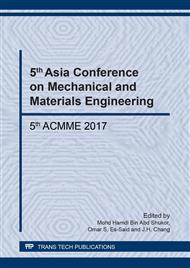p.263
p.269
p.275
p.280
p.286
p.293
p.300
p.306
p.311
Multi-Phase Microstructures for Materials with Extreme Bulk Modulus or Thermal Conductivity
Abstract:
This paper describes a methodology based on “Bidirectional Evolutionary Structural Optimization” (BESO) for topological design of microstructures of materials with more than two constituent phases. The composite material is made by repeating microstructures known as periodic base cells. The aim is to achieve appropriate topology of microstructure phases that enhances the material’s bulk or thermal conductivity performance in macro-scale. Constituent phases are divided into some groups and by performing finite element analyses on microstructure, sensitivity numbers are calculated with the application of Homogenization theory. Properties of elements are gradually changed in the finite element model based on their sensitivity numbers and controlling volume of each constituent phase in the model. Some sample microstructures are generated and presented to show the capability of the approach. The results indicate that the proposed approach is very cost efficient. Moreover, there are distinctive boundaries between the constituent phases in the generated microstructures; which is an inherent advantage of application of BESO approach.
Info:
Periodical:
Pages:
306-310
Citation:
Online since:
November 2017
Authors:
Price:
Сopyright:
© 2017 Trans Tech Publications Ltd. All Rights Reserved
Share:
Citation:


